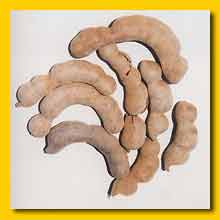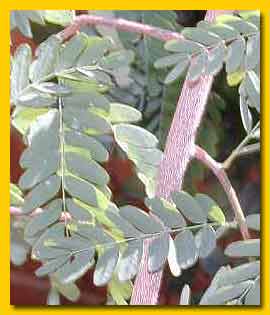|
Nov. 14, 2025
|
Keeping Quality To preserve tamarinds for future use, they may be merely shelled, layered with
sugar in boxes or pressed into tight balls and covered with cloth and kept in a
cool, dry place. For shipment to processors, tamarinds may be shelled, layered
with sugar in barrels and covered with boiling sirup. East Indians shell the
fruits and sprinkle them lightly with salt as a preservative. In Java, the
salted pulp is rolled into balls, steamed and sun-dried, then exposed to dew
for a week before being packed in stone jars. In India, the pulp, with or
without seeds and fibers may be mixed with salt (10%), pounded into blocks,
wrapped in palmleaf matting, and packed in burlap sacks for marketing. To
store for long periods, the blocks of pulp may be first steamed or sun-dried
for several days.
To preserve tamarinds for future use, they may be merely shelled, layered with
sugar in boxes or pressed into tight balls and covered with cloth and kept in a
cool, dry place. For shipment to processors, tamarinds may be shelled, layered
with sugar in barrels and covered with boiling sirup. East Indians shell the
fruits and sprinkle them lightly with salt as a preservative. In Java, the
salted pulp is rolled into balls, steamed and sun-dried, then exposed to dew
for a week before being packed in stone jars. In India, the pulp, with or
without seeds and fibers may be mixed with salt (10%), pounded into blocks,
wrapped in palmleaf matting, and packed in burlap sacks for marketing. To
store for long periods, the blocks of pulp may be first steamed or sun-dried
for several days.
Pests and DiseasesOne of the major pests of the tamarind tree in India is the Oriental yellow scale, Aonidiella orientalis. Tamarind scale, A. tamarindi, and black, or olive, scale, Saissetia oleae, are also partial to tamarind but of less importance. Butani (1970) lists 8 other scale species that may be found on the tree, the young and adults sucking the sap of buds and flowers and accordingly reducing the crop.
The mealybug, Planococcus lilacinus, is a leading pest of tamarind in India, causing
leaf-fall and sometimes shedding of young fruits. Another mealybug, Nipaecoccus
viridis, is less of a menace except in South India where it is common on many fruit
Fruit borers include larvae of the cigarette beetle, Lasioderma serricorne, also of Virachola isocrates, Dichocrocis punctiferalis, Tribolium castaneum, Phycita orthoclina, Cryptophlebia (Argyroploca) illepide, Oecadarchis sp., Holocera pulverea, Assara albicostalis, Araecerus suturalis, Aephitobius laevigiatus, and Aphomia gularis. The latter infests ripening pods on the tree and persists in the stored fruits, as do the tamarind beetle, Pachymerus (Coryoborus) gonogra, and tamarind seed borer, Calandra (Sitophilus) linearis. The rice weevil, Sitophilus oryzae, the rice moth, Corcyra cepholonica, and the fig moth, Ephestia cautella, infest the fruits in storage. The lesser grain borer, Rhyzopertha dominica bores into stored seeds. In India, a bacterial leaf-spot may occur. Sooty mold is caused by Meliola tamarindi. Rots attacking the tree include saprot, Xylaria euglossa, brownish saprot, Polyporus calcuttensis, and white rot, Trametes floccosa. The separated pulp has good keeping quality but is subject to various molds in refrigerated storage.
For more information about our company and product lines, please go to:
www.iTitropicals.com
Also, for detailed information on samples and
specifications please visit
www.iTitropicals.com
|
| Voice: +1 609 987 0550 | Copyright 2025, iTi Tropicals, Inc. |
Fax: +1 609 482 4333 |

 trees and ornamental plants. Chionaspis acuminata-atricolor and Aspidiotus spp.,
suck the sap of twigs and branches and the latter also feeds on young fruits. White
grubs of Holotrichia insularis may feed on the roots of young seedlings. The
nematodes, Xiphinema citri and Longidorus elongatus may affect the roots of older
trees. Other predators attacking the leaves or flowers include the caterpillars, Thosea
aperiens, Thalarsodes quadraria, Stauropus alternus, and Laspeyresia palamedes; the
black citrus aphid, Toxoptera aurantii, the whitefly, Acaudaleyrodes rachispora; thrips,
Ramaswamia hiella subnudula, Scirtothrips dorsalis, and Haplothrips ceylonicus; and cow bugs,
Oxyrhachis tarandus, Otinotus onerotus, and Laptoentrus obliquis.
trees and ornamental plants. Chionaspis acuminata-atricolor and Aspidiotus spp.,
suck the sap of twigs and branches and the latter also feeds on young fruits. White
grubs of Holotrichia insularis may feed on the roots of young seedlings. The
nematodes, Xiphinema citri and Longidorus elongatus may affect the roots of older
trees. Other predators attacking the leaves or flowers include the caterpillars, Thosea
aperiens, Thalarsodes quadraria, Stauropus alternus, and Laspeyresia palamedes; the
black citrus aphid, Toxoptera aurantii, the whitefly, Acaudaleyrodes rachispora; thrips,
Ramaswamia hiella subnudula, Scirtothrips dorsalis, and Haplothrips ceylonicus; and cow bugs,
Oxyrhachis tarandus, Otinotus onerotus, and Laptoentrus obliquis.
